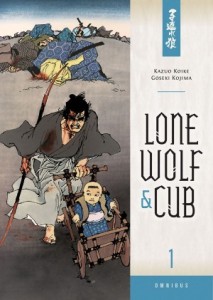By Kazuo Koike and Goseki Kojima. Released in Japan by Futabasha, serialized in the magazine Manga Action. Released in North America by Dark Horse.
I had never read Lone Wolf and Cub when I started to get into manga back in the day. My tastes ran more towards Ranma and Sailor Moon at that time, and it was also in a weird format, with smaller trim than what I was expecting. Then as it went on I simply never got a chance to go back to it. Now Dark horse is releasing the series in large omnibuses, sized like the other books on your shelves (although still flipped), with the first three volumes in this giant 700+-page monster. Is it worth picking this up?
Well, if you already have it, I wouldn’t get it again, as there’s no new translation or anything. If you don’t have it, though, this is a surprisingly gripping tale of assassination and vengeance. I say surprising as, at least for these three volumes, it’s also very episodic, bouncing back and forth between various parts of feudal Japan. It appears to all take place in the same year, given that Daigoro (the ‘Cub’ of the title) stays about 3 years old throughout, but there’s little continuity between each story, and we really don’t even know much of why Ogami is an assassination for hire beyond “he was set up and his wife was killed”. This is an early 70s seinen action manga, so there’s not a lot of heavy continuity here.
That said, this also adds to the purity of the story. Our hero roots out corruption (he even makes sure to get the FULL story from his clients, including everything they’ve done wrong, just in case) and metes out his own brand of justice. Naturally, given that the protagonists are a killer assassin and his three-year-old son, the villains tends to go either two ways: horrible and cowardly villains who die like the dogs they are, or noble-yet-conflicted samurai who duel to the death with dignity. And they all know who Lone Wolf is, not to mention his Cub. Doesn’t really stop him from getting what he wants, even if he has to take out 8 female ninja assassins, or fight on a rickety bridge, or even inside an inescapable prison.
This is, of course, written by Kazuo Koike, later known for works like Crying Freeman. It will not surprise anyone, therefore, that Ogami is also an excellent lover, though we don’t see that quite as often as I expected here. Partly as the focus of the series is sword battles, but also because the women here tend to be dead or evil – I was rather surprised when one chapter showed a thief/prostitute actually surviving to the next chapter. At least I think that’s her in the next chapter – the artist is not that great at differentiating between his characters. Luckily, Ogami’s eyebrows are large enough so he can be spotted anywhere.
This is a giant tome of a book – it may actually read easier in its original non-omnibus format – and we have a ways to go, as the series runs to the mid-20s or so, and this is only Vol. 1-3. Nonetheless, it’s highly influential, and you can see why – as a mood, the book is stellar. Recommended for those who like manly manga, swordfights, or samurai.


Speak Your Mind